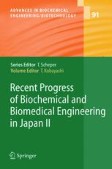Search
Search Results
-
Recent Progress in Microbial Cultivation Techniques
Recent advances in the improvement of microbial cultivation are reviewed, with emphasis on biochemical engineering techniques as a means of obtaining...
-
High Rate Production of Hydrogen/Methane from Various Substrates and Wastes
To treat soluble and solid wastes and recover energy from them, high rate methane fermentation, especially using the UASB (upflow anaerobic sludge...
-
Production and Formulation of Adenovirus Vectors
Adenovirus vectors have attracted considerable interest over the past decade, with ongoing clinical development programs for applications ranging...
-
Nonviral Delivery of Cancer Genetic Vaccines
The potential use of genetic vaccines to address numerous diseases including cancer is promising, but currently unrealized. Here, we review...
-
Advanced Targeting Strategies for Murine Retroviral and Adeno-associated Viral Vectors
Targeted gene delivery involves broadening viral tropism to infect previously nonpermissive cells, replacing viral tropism to infect a target cell...
-
Molecular Conjugates
Molecular conjugates are nanometer-sized entities consisting of synthetic materials (lipids, polycations, targeting agents, and so on) and nucleic...
-
Fish and Shellfish Upgrading, Traceability
Recognition of the limited biological resources and the increasing environmental pollution has emphasised the need for better utilisation of...
-
Marine Pharmacology: Potentialities in the Treatment of Infectious Diseases, Osteoporosis and Alzheimer's Disease
Several molecules isolated from various marine organisms (microorganisms, algae, fungi, invertebrates, and vertebrates) are currently under study...
-
Fatty Acids from Lipids of Marine Organisms: Molecular Biodiversity, Roles as Biomarkers, Biologically Active Compounds, and Economical Aspects
Because of their characteristic living environments, marine organisms produce a variety of lipids. Fatty acids constitute the essential part of...
-
Stress Induced by Recombinant Protein Production in Escherichia coli
Strong production of recombinant proteins interferes with cellular processes in many ways. Drainage of precursors and energy urges the cell to...
-
Large-Scale Micropropagation System of Plant Cells
Plant micropropagation is an efficient method of propagating disease-free, genetically uniform and massive amounts of plants in vitro. The scale-up...
-
Analysis and Control of Proteolysis of Recombinant Proteins in Escherichia coli
Proteolysis is one of the reasons for poor production of recombinant proteins in Escherichia coli. Important properties of E. coli proteases, which...
-
Novel Genes Involved in Cephalosporin Biosynthesis: The Three-component Isopenicillin N Epimerase System
Cephalosporin is one of the best β-lactam antibiotics, widely used in the treatment of infectious diseases. It is synthesized by Acremonium...
-
Control of Fluxes Towards Antibiotics and the Role of Primary Metabolism in Production of Antibiotics
Yield improvements in antibiotic-producing strains have classically been obtained through random mutagenesis and screening. An attractive alternative...
-
Marine Microalgae
Marine microalgae, the largest primary biomass, have been attracting attention as resources for new metabolites and biotechnologically useful...
-
Bioprocess Engineering Data on the Cultivation of Marine Prokaryotes and Fungi
The temperature/pressure dependency of marine prokaryotes and fungi, in terms of their growth behaviour as well as their potential to produce new...
-
Monitoring of Stress Responses
New developments in the RNA analysis techniques now enable a comprehensive view on the bacterial physiology under bioprocess conditions. The DNA-chip...
-
Clarification of Interactions among Microorganisms and Development of Co-culture System for Production of Useful Substances
Co-culture systems containing two microorganisms for the production of useful substances are described. We developed a novel co-culture system...
-
Bacterial Capsular Polysaccharide and Sugar Transferases
Capsular polysaccharides (CPs) of several pathogenic bacteria are thought to be good materials for the development of new therapeutic reagents. These...
-
Development of Culture Techniques of Keratinocytes for Skin Graft Production
The in vitro cultures of human tissues have attracted a great deal of medical attention as a promising technique for repairing defective tissues in...
